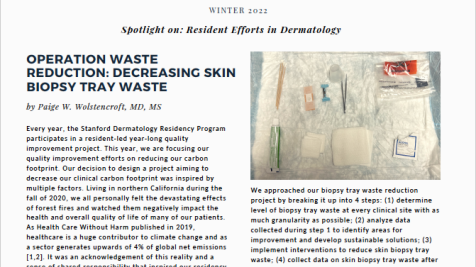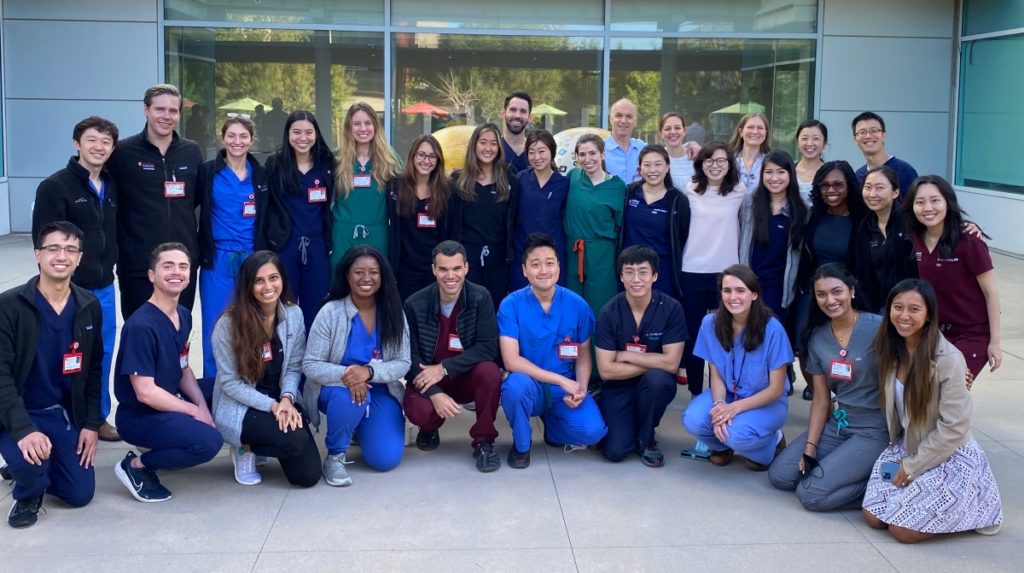Published: 04/12/2021
Dr. Paige Wolstencroft, a Stanford Dermatology Resident at the time of this interview, discusses how she and her fellow residents reduced biopsy tray waste through a quality improvement approach.

Interview by Jamie Hansen, Global Health Communications Manager
When a cohort of Stanford dermatology students had the opportunity to participate in a quality improvement project to use data to improve some aspect of their medical practice in the spring of 2021, they knew they wanted to focus on sustainability.
“This year, the connection between climate and health care has been at the forefront for many of us as we’ve seen patients impacted by heat and smoke and faced the recognition that the healthcare industry is making a huge contribution to climate change,” said Dermatology Resident Paige Wheaton Wolstencroft.
She and her colleagues, under mentorship by Dr. Bernice Kwong, chose to develop a project centered on decreasing their collective clinical carbon footprint.
I spoke with Wolstencroft about the project – and how others can apply the principles of quality improvement to greening their medical practices.

JH: How did you decide what aspect of your practice to focus on?
PW: We knew that we wanted to create a project that would allow for universal resident engagement and be both sustainable and scalable to all our clinic sites. Given the frequency with which skin biopsies are performed by all residents across clinical sites, this seemed like a natural starting point. The potential impact of reducing biopsy tray waste cannot be emphasized enough. Through our initial waste audit we determined that in one week, 46 skin biopsies were performed which leads to a conservative estimate of 2,392 skin biopsies performed each year by residents just at our dermatology program.
JH: What did you find in terms of waste when you started looking at these trays?
PW: We observed a lot of variability between clinical sites within respect to materials used as part of skin biopsy tray set-up as well as the total amount of waste. We defined waste as any item on a skin biopsy tray that was opened but unused and therefore discarded at the end of the procedure. Using this definition, we found that 84 percent of trays had at least one wasted item, and the average number of supplies wasted per tray was 7.2. Certain items – including gauze – were being wasted in higher frequency and volume than other supplies and this helped to target our intervention.
JH: How did you go about translating this finding into action?
PW: We realized that we would need individualized interventions for each clinical site given the differences between supplies used, set-up, and ultimately waste produced at different clinical sites—as well as the importance of engaging with all members of the clinic’s team. We began with the cutaneous oncology clinics and are incredibly grateful to the entire clinical team and administrative staff from this site that has been working with us to implement changes to optimize and define what is needed on a biopsy tray. Through teamwork and collaboration, we have been able to replace the thick chux covering biopsy trays with a thinner paper, ordered skin markers that are smaller and not individually packaged, and created a new workflow for biopsy tray set-up that minimizes the number of items on the tray at the beginning of a skin biopsy. We’re in the process of conducting another waste audit to quantify how much impact we’ve been able to make.
JH: Recognizing that this project is still underway, what’s one of your main takeaways so far?
PW: Meaningful resident involvement in waste reduction projects is feasible and essential and biopsy trays can and should be optimized to decrease waste. Collaboration with the entire clinical and administrative staff is critical to implementing sustainable change. Our project would not have been possible or successful without the support and insights from every member of the clinical team and we are grateful for everyone’s enthusiastic participation.
In the spirit of collaboration, which is so essential to sustainability and climate change, I would like to thank the Stanford Department of Anesthesiology, Perioperative and Pain Medicine for sharing their approach to reducing operating room waste as well as the Stanford Resident Safety Council and specifically the Greening the Clinics team for their education on performing waste audits.
